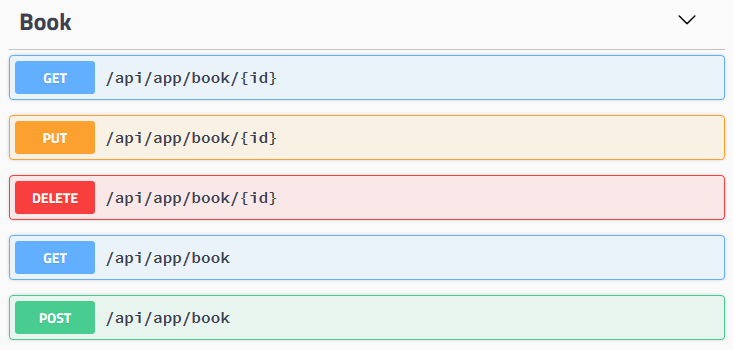
ABP Framework is a complete infrastructure for creating software solutions with modern architectures based on the ASP.NET Core platform.
Source CodeABP CLI is a command line tool to perform common development tasks for ABP-based solutions.
# Create a new layered application
abp new Acme.BookStore
# Create a new layered application using MongoDB
abp new Acme.BookStore -d mongodb
# Add a new module to the solution
abp add-module Volo.Blogging
ABP provides a complete infrastructure to build your own application modules that may have entities, services, database integration, APIs, UI components and so on..
[DependsOn(
typeof(AbpEntityFrameworkCoreModule), //Depending on a framework module
typeof(MyBusinessModule) //Depending on your own module
)]
public class MyAppModule : AbpModule
{
public override void ConfigureServices(ServiceConfigurationContext context)
{
//Configure DI and other modules...
}
public override void OnApplicationInitialization(ApplicationInitializationContext context)
{
//Perform some application initialization logic...
}
}ABP doesn't only support developing multi-tenant applications, but also makes your code mostly unaware of the multi-tenancy. It can automatically determine the current tenant, isolate data of different tenants from each other. It supports single database, database per tenant and hybrid approaches.
You focus on your business code and let the framework handle multi-tenancy on behalf of you.

Instead of manually writing the repeating details of bootstrap components, use ABP's tag helpers to simplify it and take advantage of the IntelliSense. You can directly use Bootstrap whenever you need it.
<abp-card>
<img abp-card-image="Top" src="" data-src="/images/my-dog.png" class="lazy" loading="lazy"
width="250" heigth="162"/>
<abp-card-body>
<abp-card-title>Card title</abp-card-title>
<abp-card-text>
<p>
This is a sample card component built by ABP bootstrap
card tag helper. ABP has tag helper wrappers for most of
the bootstrap components.
</p>
</abp-card-text>
<a abp-button="Primary" href="javascript:void(0)" >Go somewhere →</a>
</abp-card-body>
</abp-card>
Dynamic form & input tag helpers can create the complete form from a C# class as the model.
<abp-dynamic-form abp-model="@Model.PersonInput" submit-button="true" />public class PersonModel
{
[HiddenInput]
public Guid Id { get; set; }
[Required]
[EmailAddress]
[StringLength(255)]
public string Email { get; set; }
[Required]
[StringLength(32)]
[DataType(DataType.Password)]
public string Password { get; set; }
[StringLength(255)]
public string Address { get; set; }
public Gender Gender { get; set; }
}Rich authentication & authorization options integrated to ASP.NET Core Identity & OpenIddict. Provides an extensible & detailed permission system.
Don't repeat yourself to implement all this common stuff again & again. Focus on your business code and let ABP automate them by conventions.
ABP provides an optimistic concurrency check mechanism to ensure data consistency in your application and prevents users access or change the same data in a database at the same time.
public class Book : Entity<Guid>, IHasConcurrencyStamp
{
public string ConcurrencyStamp { get; set; }
//...
}
ABP offers a simple, dynamic, powerful, modular and built-in bundling & minification system.
<abp-style-bundle name="MyGlobalBundle">
<abp-style src="/libs/bootstrap/css/bootstrap.css" />
<abp-style src="/libs/font-awesome/css/font-awesome.css" />
<abp-style src="/libs/toastr/toastr.css" />
<abp-style src="/styles/my-global-style.css" />
</abp-style-bundle>The Virtual File System makes it possible to manage files that do not physically exist on the file system (disk). It's mainly used to embed the (js, css, image, cshtml...) files into assemblies and use them like physical files on runtime.

Theming system allows developing your application & modules theme independent by defining a set of common base libraries and layouts, based on the latest Bootstrap framework.

Define simple classes to execute jobs in the background as queued. Use the built-in job manager or integrate your own. Hangfire, RabbitMQ and Quartz integrations are already available.
public class EmailSendingJob : BackgroundJob<EmailSendingArgs>
{
private readonly IEmailSender _emailSender;
public EmailSendingJob(IEmailSender emailSender)
{
_emailSender = emailSender;
}
public override void Execute(EmailSendingArgs args)
{
_emailSender.Send(
args.EmailAddress,
args.Subject,
args.Body
);
}
}Define operations to run in a separate, dedicated thread. Use the built-in background workers or integrate your own. Hangfire and Quartz integrations are already available.
public class PassiveUserCheckerWorker : AsyncPeriodicBackgroundWorkerBase
{
public PassiveUserCheckerWorker(
AbpAsyncTimer timer,
IServiceScopeFactory serviceScopeFactory
) : base(
timer,
serviceScopeFactory)
{
Timer.Period = 6000;
}
protected async override Task DoWorkAsync(
PeriodicBackgroundWorkerContext workerContext)
{
Logger.LogInformation("Starting: Setting status of inactive users...");
//Resolve dependencies
var userRepository = workerContext
.ServiceProvider
.GetRequiredService<IUserRepository>();
//Do the work
await userRepository.UpdateInactiveUserStatusesAsync();
Logger.LogInformation("Completed: Setting status of inactive users...");
}
}
A complete infrastructure to build layered applications based on the Domain Driven Design patterns & principles;
public class BookAppService : ApplicationService, IBookAppService
{
private readonly IRepository<Book, Guid> _bookRepository;
public BookAppService(IRepository<Book, Guid> bookRepository)
{
_bookRepository = bookRepository;
}
public async Task CreateAsync(CreateBookDto input)
{
var book = new Book(
GuidGenerator.Create(),
input.Name,
input.Type,
input.Price
);
await _bookRepository.InsertAsync(book);
}
}ABP can automatically configure your application services as API Controllers by convention.

ABP allows for the graceful termination of asynchronous operations in applications, ensuring proper resource cleanup and responsive user experience.
Easily consume your APIs from JavaScript and C# clients.
//Call remote APIs just like local functions in JavaScript
acme.bookStore.book
.getList({})
.done(function (result) {
//...
});Easily publish & consume distributed events using built-in Distributed Event Bus with RabbitMQ, Kafka, Rebus and Azure integrations
public class PublisherDemo : ITransientDependency
{
private readonly IDistributedEventBus _distributedEventBus;
public PublisherDemo(
IDistributedEventBus distributedEventBus)
{
_distributedEventBus = distributedEventBus;
}
public async Task RunAsync()
{
//Publish an event
await _distributedEventBus.PublishAsync(
new StockCountChangedEvent(productId, 42)
);
}
}public class MyEventHandler
: IDistributedEventHandler<StockCountChangedEvent>
{
public Task HandleEventAsync(StockCountChangedEvent eventData)
{
//Handle the event and execute your business
}
}ABP's distributed locking system ensures that resources are accessed in a mutually exclusive manner across different nodes in a distributed environment, preventing concurrent conflicts and ensuring data consistency.
using Volo.Abp.DistributedLocking;
namespace AbpDemo
{
public class MyService : ITransientDependency
{
private readonly IAbpDistributedLock _distributedLock;
public MyService(IAbpDistributedLock distributedLock)
{
_distributedLock = distributedLock;
}
public async Task MyMethodAsync()
{
await using (var handle = await _distributedLock.TryAcquireAsync("MyLockName"))
{
if (handle != null)
{
// your code that access the shared resource
}
}
}
}
}
BLOB Storing system provides an abstraction to work with BLOBs. ABP provides some pre-built storage provider integrations (Azure, AWS, File System, Database, etc.) that you can easily use in your applications.
public class MyService : ITransientDependency
{
private readonly IBlobContainer _blobContainer;
public MyService(IBlobContainer blobContainer)
{
_blobContainer = blobContainer;
}
public async Task SaveBytesAsync(byte[] bytes)
{
await _blobContainer.SaveAsync("my-blob", bytes);
}
public async Task<byte[]> GetBytesAsync()
{
return await _blobContainer.GetAllBytesOrNullAsync("my-blob");
}
}Text templating is used to dynamically render contents based on a template and a model (a data object). For example, you can use it to create dynamic email contents with a pre-built template.
var result = await _templateRenderer.RenderAsync(
"PasswordReset", //the template name
new PasswordResetModel
{
Name = "john",
Link = "https://abp.io/example-link?userId=123&token=ABC"
}
);The framework has been developed with unit & integration testing in mind. Provides you base classes to make it easier. Startup templates come pre-configured for testing.
public class MyService_Tests : AbpIntegratedTest<MyModule>
{
private readonly MyService _myService;
public MyService_Tests()
{
_myService = GetRequiredService<MyService>();
}
[Fact]
public async Task MyService_Should_Do_It()
{
//Act
var result = _myService.DoIt();
//Assert
result.ShouldBe(42);
}
}Built-in audit logging for business-critical applications. Request, service, method level audit logging and entity histories with property-level details.
public class PersonService
{
//Inject IObjectMapper
private readonly IObjectMapper _objectMapper;
public PersonService(IObjectMapper objectMapper)
{
_objectMapper = objectMapper;
}
public PersonDto GetPerson(Guid id)
{
Person person = GetPersonEntityFromRepository(id);
//Use for Entity to DTO mapping
return _objectMapper.Map<Person, PersonDto>(person);
}
}IEmailSender and ISmsSender abstractions decouples your application logic from the infrastructure. Advanced email template system allows to create & localize email templates and easily use whenever needed.
public async Task SendWelcomeEmailAsync(string emailAddress, string name)
{
//Get the email template
var template = await _emailTemplateProvider.GetAsync("WelcomeEmailTemplate");
//Replace placeholders
template.Replace("name", name);
//Send email
await _emailSender.SendAsync(
emailAddress,
"Welcome to our application!",
template.Content
);
}Localization system allows creating resources in plain JSON files and uses them to localize your UI. It supports advanced scenarios like inheritance, extensions and JavaScript integration while it is fully compatible with AspNet Core's localization system.
{
"culture": "en",
"texts": {
"WelcomeMessage": "Welcome to the application!",
"HelloWorld": "Hello World"
}
}Define settings for your application and get the values on runtime based on the current configuration, tenant and user.
Don't repeat yourself even for trivial code parts. Extensions & helpers for standard types make your code much cleaner and easy to write.
//Convert a string to camelCase
"HelloWorld".ToCamelCase(); //returns "helloWorld"
//Truncate a string with "..." postfix
"This is a test string".TruncateWithPostfix(12); //returns "This is a..."
//Convert a string to int
"42".To<int>(); //returns 42 as int
//Check if a value occurs in a list
5.IsIn(1, 3, 5, 7); //returns true
//Check if a value is between a range
5.IsBetween(6, 12); //returns falseProvides a comfortable infrastructure to create dynamic proxies and implement Aspect Oriented Programming. Intercept any class and execute your code before & after every method execution.
//Inherit from the AbpInterceptor to log all method executions
public class MyLoggingInterceptor : AbpInterceptor, ITransientDependency
{
private readonly ILogger<MyLoggingInterceptor> _logger;
public MyLoggingInterceptor(ILogger<MyLoggingInterceptor> logger)
{
_logger = logger;
}
public async override Task InterceptAsync(IAbpMethodInvocation invocation)
{
LogInvocation(invocation);
await invocation.ProceedAsync();
}
private void LogInvocation(IAbpMethodInvocation invocation)
{
/* Access to all the information about the method execution
* including method, class and provided arguments */
_logger.LogInformation(
"Executing the method: " +
invocation.Method.Name +
" of class " +
invocation.TargetObject.GetType().FullName
);
}
}No need to register your classes to dependency injection manually. Automatically registers common service types by convention. For other type of services, you can use interfaces and attributes to make it easier and in-place.
/* Automatically registers MyService as transient.
* Then you can inject by IMyService or MyService.
*/
public class MyService : IMyService, ITransientDependency
{
}Define and use data filters that are automatically applied when you query entities from the database. Soft Delete & MultiTenant filters are provided out of the box when you implement simple interfaces.
public class MyEntity : Entity<Guid>, ISoftDelete
{
public bool IsDeleted { get; set; }
}
ABP provides string encryption feature that allows to Encrypt and Decrypt strings.
public class MyService : DomainService
{
protected IStringEncryptionService StringEncryptionService { get; }
public MyService(IStringEncryptionService stringEncryptionService)
{
StringEncryptionService = stringEncryptionService;
}
public string Encrypt(string value)
{
// To enrcypt a value
return StringEncryptionService.Encrypt(value);
}
public string Decrpyt(string value)
{
// To decrypt a value
return StringEncryptionService.Decrypt(value);
}
}